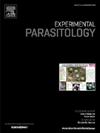Ultrastructural characterization and pathogenicity of Allovohlkamfia spelaea in a murine model: Neuropulmonary infections and therapeutic potential of ellagic acid
IF 1.6
4区 医学
Q3 PARASITOLOGY
引用次数: 0
Abstract
Background
Allovahlkampfia spelaea (A. spelaea) is a free-living amoeba that has recently been recognized to cause Acanthamoeba-like keratitis, the treatment of which is complex. The pathogenic potential of Allovahlkampfia spp. remains unexplored. This study characterized A. spelaea through ultrastructural morphological analysis and investigated the pathogenic potential of the A. spelaea strain KS1, which was isolated from a patient with keratitis, in a murine model, with a focus on neuro-pulmonary infections. Additionally, this study assessed the therapeutic effectiveness of ellagic acid (EA) against tissue damage caused by amoebic infections.
Methods
Immunosuppressed male Wister rats were intranasally inoculated with A. spelaea trophozoites (1 × 106/ml) and divided into control, infected untreated, and infected treated (50 mg/kg EA daily) groups. Histopathological and ultrastructural analyses of brain and lung tissues were conducted by scanning and transmission electron microscopy. Additionally, the therapeutic effects of EA were assessed via comparative tissue pathology.
Results
A. spelaea infection induced A. spelaea-induced neural lesions resembling granulomatous amoebic encephalitis (GAE) in the brain, which was characterized by gliosis, vasculitis, and necrosis, in addition to severe pulmonary damage, including suppurative bronchopneumonia and abscesses. Trophozoites presented with pseudopodia, acanthopodia, and amoebostomes, whereas cysts presented with double-layered walls. EA-treated rats presented nearly normal brain and lung histology, with reduced inflammation and gliosis, highlighting the anti-inflammatory and antioxidant properties of EA.
Conclusion
This study highlights the neurotropic and pulmonary pathogenicity of A. spelaea, with ultrastructures parallel to those of Vahlkampfia spp. and Acanthamoeba spp. Ellagic acid significantly reduces infection-induced damage, underscoring its potential as a therapeutic agent for infections caused by free-living amoebae.

小鼠神经肺部感染模型的超微结构特征和致病性:鞣花酸的治疗潜力。
背景:Allovahlkampfia spelaea (a . spelaea)是一种自由生活的变形虫,最近被认为是引起棘阿米巴样角膜炎,其治疗是复杂的。Allovahlkampfia spp.的致病潜力仍未探明。本研究通过超微结构形态学分析对spelaea进行了表征,并在小鼠模型中研究了从角膜炎患者中分离到的spelaea菌株KS1的致病潜力,重点研究了神经-肺部感染。此外,本研究评估了鞣花酸(EA)对阿米巴感染引起的组织损伤的治疗效果。方法:对免疫抑制的雄性Wister大鼠鼻内接种褐皮草滋养体(1×106/ml),分为对照组、感染未处理组和感染处理组(50 mg/kg EA每日)。采用扫描电镜和透射电镜对脑组织和肺组织进行组织病理学和超微结构分析。此外,通过比较组织病理学评估EA的治疗效果。结果:spelae感染可引起脑内类似肉芽肿性阿米巴脑炎(GAE)的神经病变,表现为神经胶质瘤、血管炎和坏死,并伴有严重的肺损害,包括化脓性支气管肺炎和脓肿。滋养体表现为假足、棘足和变形虫,而囊肿表现为双层壁。经ea处理的大鼠脑组织和肺组织基本正常,炎症和神经胶质瘤减少,显示了ea的抗炎和抗氧化作用。这项研究强调了a . spelaea的嗜神经性和肺致病性,其超微结构与Vahlkampfia spp.和棘阿米巴spp.相似。鞣花酸显著减少感染引起的损伤,强调了其作为治疗由自由生活的阿米巴引起的感染的药物的潜力。
本文章由计算机程序翻译,如有差异,请以英文原文为准。
求助全文
约1分钟内获得全文
求助全文
来源期刊

Experimental parasitology
医学-寄生虫学
CiteScore
3.10
自引率
4.80%
发文量
160
审稿时长
3 months
期刊介绍:
Experimental Parasitology emphasizes modern approaches to parasitology, including molecular biology and immunology. The journal features original research papers on the physiological, metabolic, immunologic, biochemical, nutritional, and chemotherapeutic aspects of parasites and host-parasite relationships.
 求助内容:
求助内容: 应助结果提醒方式:
应助结果提醒方式:


